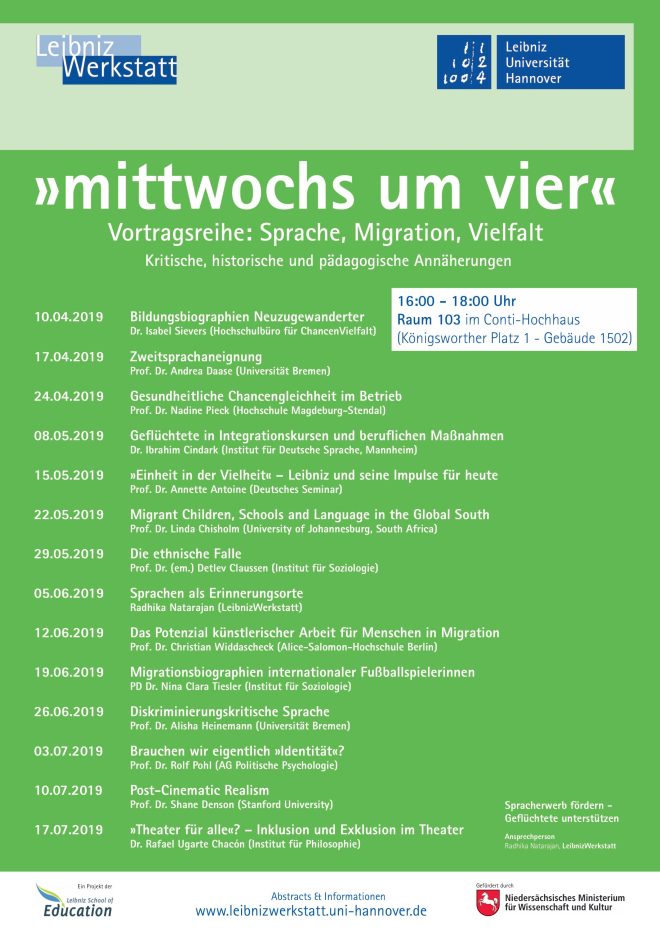
On July 10, 2019, I will be giving a talk titled “Post-Cinematic Realism” at the LeibnizWerkstatt lecture series on Sprache, Migration, Vielfalt at the Leibniz Universität Hannover. Thanks to Radhika Natarajan for inviting me!

On July 10, 2019, I will be giving a talk titled “Post-Cinematic Realism” at the LeibnizWerkstatt lecture series on Sprache, Migration, Vielfalt at the Leibniz Universität Hannover. Thanks to Radhika Natarajan for inviting me!
Here’s the course description for a graduate-level course I’ll be teaching in the winter semester (October 2013 – February 2014) — a PDF of the full syllabus is embedded above:
Digital Film, Chaos Cinema, Post-Cinematic Affect: Thinking 21st Century Motion Pictures
Instructor: Shane Denson
Course Description:
In this seminar, we will try to come to terms with twenty-first century motion pictures by thinking through a variety of concepts and theoretical approaches designed to explain their relations and differences from the cinema of the previous century. We will consider the impact of digital technologies on film, think about the cultural contexts and aesthetic practices of contemporary motion pictures, and try to understand the experiential dimensions of spectatorship in today’s altered viewing conditions. In addition to preparing weekly readings, students will be expected to view a variety of films prior to each class meeting.
Course Themes and Objectives:
In this course, we set out from the apparent “chaos” that contemporary cinema often presents to us: the seemingly incoherent and unmotivated camerawork and editing, for example, by which many action films of the twenty-first century mark their departure from the “classical” norms of Hollywood-style narration and formal construction. From here, we seek to make sense more generally of cinema’s transformation in terms of new technologies and techniques (e.g. digital imaging processes, nonlinear editing, and attendant editing styles), in terms of new modes of cinematic distribution and reception (e.g. DVD, Blu-Ray, and streaming services, HD TVs, smartphones, and tablet computers, but also IMAX 3-D and similar transformations of the big screen), in terms of non-classical narrative styles (e.g. recursive, database-like, non-linear, and even non-sequitur forms of storytelling), and in terms of broader phenomenological and environmental shifts that inform our experience, our embodiment, and our subjectivity in the digital era.
Several key concepts will help to orient our thinking about twenty-first century cinema and its relation to earlier cinematic modes. The first is “chaos cinema,” a term which Matthias Stork popularized in a compelling set of video essays focused particularly on recent action cinema; beyond this context, however, Stork’s notion of “chaos” resonates with the feelings and fears of many critics and theorists in the face of digital-era cinema. This broader perception of chaos is sometimes traced back to the digital unmooring of images from the indexical referents to which photographic films remained tied; on this basis, the somewhat oxymoronic term “digital film” is often linked to an even more unsettling, because more basic, sense of chaos: according to some critics, the digital (and the moving images it produces and supports) is correlated with a sweeping transformation of human society and subjectivity itself. On the other hand, though, not all critics are similarly alarmed by digital-era chaos. David Bordwell’s concept of “intensified continuity” effectively denies the radical stylistic break announced in Stork’s analysis; Bordwell sees the newer films as perhaps faster and even more hectic than classical Hollywood fare, but basically constructed according to principles of classical continuity – just intensified. By way of contrast, Steven Shaviro’s notion of “post-continuity” – developed in the context of his analysis of “post-cinematic affect” – provides another view of contemporary moving image culture, one which links formal and aesthetic transformations not only with new technologies but also with broader social, cultural, and economic changes underway right now.
As we think through these and related concepts, we will engage a variety of recent movies from formal, phenomenological, affective, cultural, and environmental perspectives. We will seek to understand whether a radical change has taken place in recent cinema, to assess what its significance might be, and in this way begin to think through the implications of and for our viewing habits in the twenty-first century.
You can find more of my syllabi here: http://uni-hannover.academia.edu/ShaneDenson
Here are some images from our symposium “Imagining Media Change,” which took place on June 13, 2013:
Above, Ruth Mayer opening the symposium with some nice words of welcome.
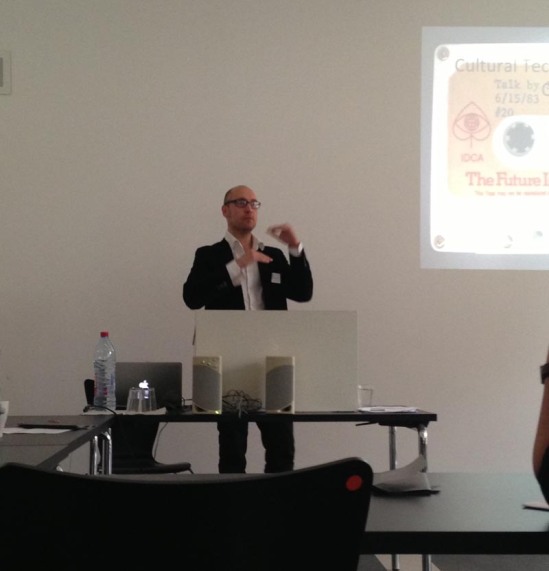 Jussi Parikka talking about “Cultural Techniques of Cognitive Capitalism: On Change and Recurrence” in his wonderful opening keynote.
Jussi Parikka talking about “Cultural Techniques of Cognitive Capitalism: On Change and Recurrence” in his wonderful opening keynote.
 Florian Groß delivering his talk “The Only Constant is Change: American Television and Media Change Revisited” — with examples from Mad Men.
Florian Groß delivering his talk “The Only Constant is Change: American Television and Media Change Revisited” — with examples from Mad Men.
 Bettina Soller on hypertext and fanfic in her talk “How We Imagined Electronic Literature and Who Died: Looking at Fan Fiction to See What Became of the Future of Writing”.
Bettina Soller on hypertext and fanfic in her talk “How We Imagined Electronic Literature and Who Died: Looking at Fan Fiction to See What Became of the Future of Writing”.
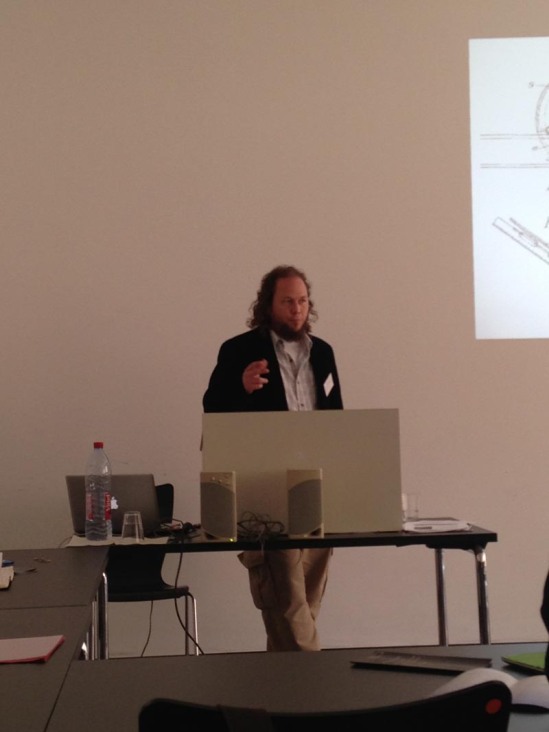 Me, Shane Denson, on escalators and “On NOT Imagining Media Change”.
Me, Shane Denson, on escalators and “On NOT Imagining Media Change”.
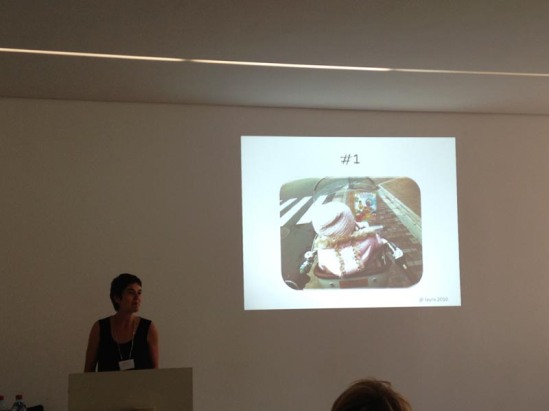 Wanda Strauven delivering the second keynote, “Pretend (&) Play: Children as Media Archaeologists” — a lively talk with great examples!
Wanda Strauven delivering the second keynote, “Pretend (&) Play: Children as Media Archaeologists” — a lively talk with great examples!
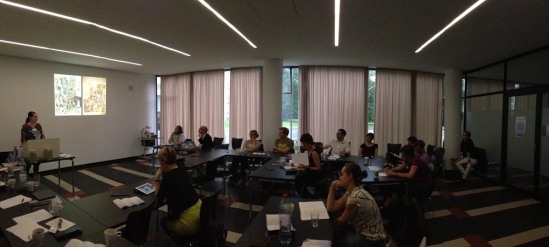 Christina Meyer talking about the Yellow Kid and “Technology – Economy – Mediality: Nineteenth Century American Newspaper Comics”.
Christina Meyer talking about the Yellow Kid and “Technology – Economy – Mediality: Nineteenth Century American Newspaper Comics”.
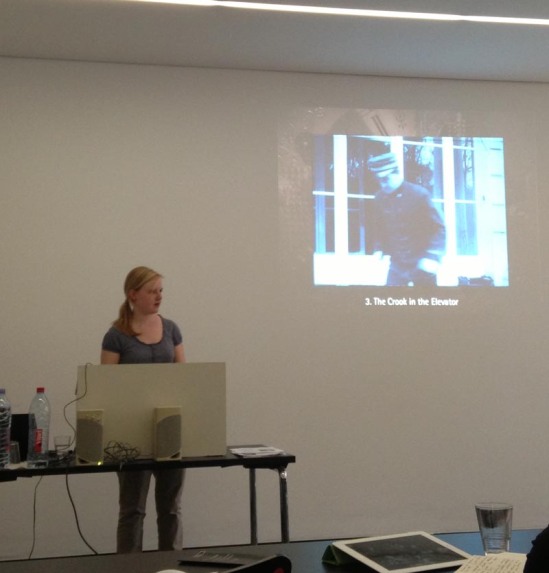 Ilka Brasch talking about early film serials and “Facilitating Media Change: The Operational Aesthetic as a Receptive Mode”.
Ilka Brasch talking about early film serials and “Facilitating Media Change: The Operational Aesthetic as a Receptive Mode”.
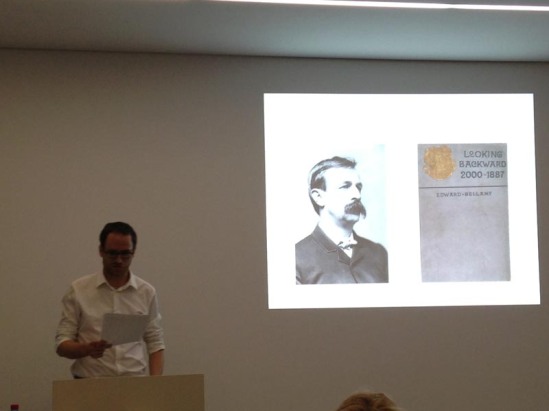 Alexander Starre wrapping up the symposium with an excellent talk on “Evolving Technologies, Enduring Media: Material Irony in Octave Uzanne’s ‘The End of Books’”.
Alexander Starre wrapping up the symposium with an excellent talk on “Evolving Technologies, Enduring Media: Material Irony in Octave Uzanne’s ‘The End of Books’”.
And finally, here are a few more random pictures:
After successfully celebrating the “conceptual centerpiece” of this term’s media initiative activities — our symposium on “Imagining Media Change” — we are going to wrap up this semester’s film series with a screening of Martin Scorsese’s Hugo (2011), curated by Ilka Brasch.
On the one hand, Hugo is a celebration not only of George Méliès (the French filmmaker who is considered to be one of cinema’s founding fathers and a pivotal creator of early trick film), but a collage of 19th and early 20th century media-technological history, featuring everything from trains and automata to late 19th century trick film and 1920s comedy. On the other hand, however, Hugo is also a celebration of the possibilities enabled by the digital age’s return to 3D. As Therese Grisham has pointed out, Hugo draws on “cultural stereotypes of the past” while simultaneously underlining “our definite entry into the episteme of the post-cinematic”.
Besides offering a form of bricolage or pastiche, Hugo can be read in terms of media archaeology, as both a revisiting and appropriation of visual culture’s history. The film assembles 19th and early 20th century anecdotes in order to provide a new 21stcentury or even post-cinematic anecdote.
As always, the screening — on Wednesday, June 19, 2013 (at 6:00 pm in room 615, Conti-Hochhaus) is free and open to all.
Also, if you haven’t already done so, you might want to consider watching Méliès’ Le Voyage Dans La Lune, one of the turn of the century trick films to which much in Hugo relates back. Here’s an excerpt:
Here is the final program for our symposium “Imagining Media Change” (print version above, and links to each speaker’s abstract below):
Imagining Media Change — June 13, 2013, Leibniz Universität Hannover
9:30 — Welcome, Ruth Mayer (Chair of American Studies, Hannover)
9:45 – 11:15 — Keynote I, Jussi Parikka (Southampton): “Cultural Techniques of Cognitive Capitalism: On Change and Recurrence”
11:15 – 11:45 — coffee break
11:45 – 13:15 — Panel I:
11:45 — Florian Groß (Hannover): “The Only Constant is Change: American Television and Media Change Revisited”
12:15 — Bettina Soller (Göttingen): “How We Imagined Electronic Literature and Who Died: Looking at Fan Fiction to See What Became of the Future of Writing”
12:45 — Shane Denson (Hannover): “On NOT Imagining Media Change”
13:15 – 15:00 — lunch break
15:00 – 16:30 — Keynote II, Wanda Strauven (Amsterdam): “Pretend (&) Play: Children as Media Archaeologists”
16:30 – 17:00 — coffee break
17:00 – 18:30 — Panel II:
17:00 — Christina Meyer (Hannover): “Technology – Economy – Mediality: Nineteenth Century American Newspaper Comics”
17:30 — Ilka Brasch (Hannover): “Facilitating Media Change: The Operational Aesthetic as a Receptive Mode”
18:00 — Alexander Starre (Berlin): “Evolving Technologies, Enduring Media: Material Irony in Octave Uzanne’s ‘The End of Books'”
19:30 — symposium dinner
Abstract for Jussi Parikka’s keynote talk at the symposium “Imagining Media Change” (June 13, 2013, Leibniz Universität Hannover):
Cultural Techniques of Cognitive Capitalism: On Change and Recurrence
Jussi Parikka
This talk has primarily two functions and aims. Firstly, it discusses the concept of cognitive capitalism from the perspective of its constituent cultural techniques. It proposes the ever so slightly unholy wedding together of post-fordist political theory with some currents in German media theory. This is done in order to discuss some of the mediatic aspects of the notion of cognitive capitalism (Yann Moulier Boutang). Secondly, the talk discusses media cultural change and the temporalities in which such notions like cognitive capitalism are distributed. By discussing software culture it argues for the various temporalities of change that are always at play in media cultural perspective.
Abstract for Florian Groß’s talk at the symposium “Imagining Media Change” (June 13, 2013, Leibniz Universität Hannover):
The Only Constant is Change: American Television and Media Change Revisited
Florian Groß
“This device isn’t a spaceship, it’s a time machine. Goes backwards, forwards. It takes us to a place where we ache to go again.” This is how 1960s adman Don Draper describes a slide projector in the historical television series Mad Men, and his pitch is also a potent way of describing the medium itself. From its development out of radio and film to its present convergence with digital media, television’s interaction with other media and processes of media change was often linked to its negotiation of the future and the past, progress and retrospection, and innovation and nostalgia.
This paper argues that in order to understand the future of television and the potential results of its increasing interaction with digital media, an understanding of the medium’s past as well as television’s own understandings of its past is instrumental. In this context, Mad Men’s historiography and its attempt to unearth and create historical material helps us to come to terms with the layers of television’s past whose residues always coexist with the medium in transition and continue to influence the shape of televisual things to come.
Abstract for Bettina Soller’s talk at the symposium “Imagining Media Change” (June 13, 2013, Leibniz Universität Hannover):
How We Imagined Electronic Literature and Who Died: Looking at Fan Fiction to See What Became of the Future of Writing
Bettina Soller
Starting in the pre-Web era, the first emergence of electronic literature was accompanied by a wave of theoretical writings about literary hypertext. Theorists had visions of the escape from the book’s linearity and the far-reaching effects of hypertext on the future of reading and writing. Enthralled by the newness of the media, critics envisioned the death of the book, the author, the reader, and the editor in an effort to make sense of the changes awaiting literature, while at the same time establishing a canon of e-literature and the notion of a high culture of hypermedia practices.
Since then, the end of the golden age of hypertext literature has been announced. Literary studies degraded electronic and digital literature to one of its marginal subject matters. While the circus moved on, forms of writing that challenge established notions of text, work, author, and reader thrive online and extensively outnumber the canon of electronic literature established by first wave critics. This paper will examine fan fiction as one of the most proliferating digital and online writing phenomena. Fan fiction writing encompasses the practice of readers who become authors expanding, appropriating and transforming texts of popular culture. These fan texts are published in online archives and on personal sites in social journaling portals. Through an examination of this electronic literature phenomenon, some of the major theses of hypertext theory will be reexamined to see what became of the future of writing and who actually died.
Abstract for Shane Denson’s talk at the symposium “Imagining Media Change” (June 13, 2013, Leibniz Universität Hannover):
On NOT Imagining Media Change
Shane Denson
There are many ways in which we imagine media change and technological transformation; foremost among them, in the modern era, are popular and commercial visions of the future – from science-fiction narratives to advertisements for the latest gadget guaranteed to change your life. However, if we suppose that human agencies are inextricably tied to, and in part enabled by, the material infrastructure of a media-technological environment, then our imaginations – as they are focused, reflected, or courted in representational media – must be seen to lag behind infrastructural shifts, which would sweep our imagining subjectivities along with them. If, that is, our capacity to imagine media change is itself mediated through a changing media-technological environment, then certain aspects of media change must be categorically immune to imagination.
In this presentation, I will focus on this phenomenon of NOT imagining media change. I will outline a theoretical model according to which media change pertains not only to empirically determinate transformations in media-technical apparatuses and systems, but more broadly to the environmental substrate of discursive and phenomenological subjectivities. I will argue that a pre-reflective “anthropotechnical interface,” based in proprioceptive and visceral sensibilities, constitutes the primary site of media change. Accordingly, the embodied parameters of our imaginative faculties are themselves subject to radical transformation, such that both spectacular and unobtrusive changes in the media environment can occasion deep changes in our experiential frameworks – changes that elude representation and imagination.
Abstract for Wanda Strauven’s keynote talk at the symposium “Imagining Media Change” (June 13, 2013, Leibniz Universität Hannover):
Pretend (&) Play: Children as Media Archaeologists
Wanda Strauven
In this talk, I will present a series of concrete situations where children make, very intuitively, connections between the past, the present and the future of media. In their play, children often “imagine” future media applications by actually applying them. Their imagination is therefore more than just a fantasy or mental fabrication; it is instead a practice or “form of activity” (Tätigkeit), to use Siegfried Zielinski’s definition of media archaeology. Especially in their act of “repurposing” media and other devices, children become true media archaeologists. In other words, I will offer some thoughts about the child’s play as a media-archaeological laboratory. For this purpose, I will also take into account some general theories about play, game, object lesson, optical toys and language.